One of the oldest religions, Hinduism, also has one of the biggest congregations of followers. Over a billion people around the world follow this faith. Sure, the majority of the followers of this faith are based around the Indian subcontinent. However, the influence of Hinduism stretches far and wide. In fact, you will find Hindu communities spread around the globe!
Unlike many other religions, Hinduism does not have a single founder or a strict set of rules that everyone follows. This certainly makes this faith quite unique in this regard. Think of Hinduism as a giant tree with many branches – different ways of thinking, believing, and finding meaning in life. They have all grown from the same roots, interconnected but still somewhat independent of each life. This is the best way for us to describe Hinduism to those who are learning about it for the first time and are not intricately familiar with it.
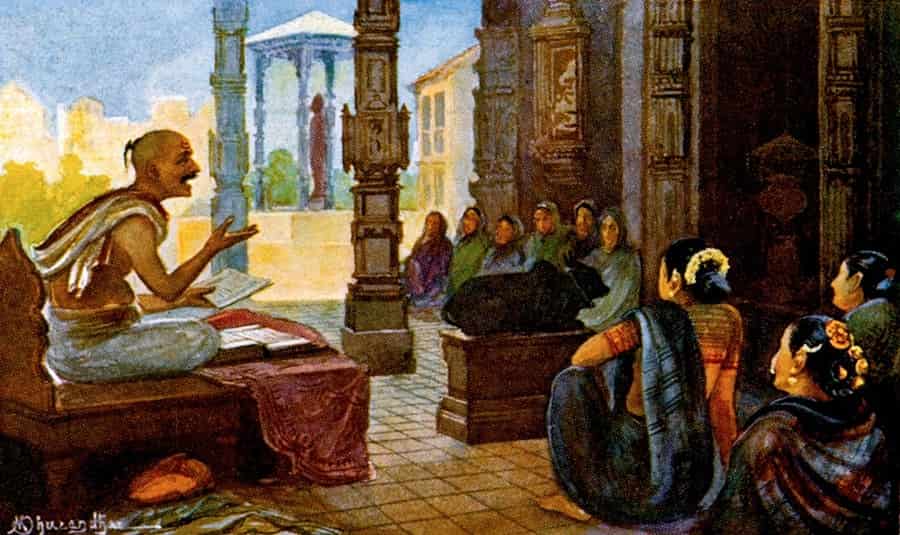
However, just because you are uninitiated and unfamiliar with the ways of life in Hinduism, it does not mean you have to be ignorant of it. But you also do not have to read ancient scrolls and books to learn about this faith. Here, we have created a guide that will help you explore this fascinating religion. We will journey through the history of this religion, learn about its important beliefs, and see how it shapes lives all over the world. So, are you ready to discover something that is truly amazing? Fasten your seat belts and prepare for the ride that will change how you see the world!
Defining the Term Hinduism (& Hindu)
Before we go and explore Hinduism any further, we first must talk about where the word ‘Hinduism ‘ comes from. Now, before we start pinning down a single definition, it is important for us to emphasize the impossibility of this task. In fact, it is a bit like trying to catch water in your hands. Hinduism is a complex, diverse faith that evolved over thousands of years, with seemingly no proper origin. At its core, the term “Hinduism” defines the religious, philosophical, and cultural traditions that are prevalent in the Indian subcontinent.
Now, if you are asking where the term came from, well, that is an issue, as there is no concrete answer to this. In fact, the term “Hindu” itself has a geographical origin. It was actually used by early travelers (Greeks and Persians) to describe people living across the Indus River. The word Hindu is a direct derivation from the Greek word ‘indoi’. It should be pointed out that while this term has generally become acceptable in the community as a whole, many still prefer to use the term ‘Sanatana Dharma’ when talking about this ancient religion.
You must understand that what unites “Hindus” is not just the term or a rigid creed but actually beliefs of several shared concepts. These include karma, dharma, and moksha, amongst others. Instead of one path – set in stone – Hinduism actually is a set of several paths that one can take to reach the divine. This naturally makes this religion more free, relaxed – allowing for personal expression, regional variations and more.
But while this may answer the question about why the term Hindu & Hinduism is used, it raises even more questions. Starting with – What are the Origins of Hinduism?
Origins & History of Hinduism
Now that we have cleared up why terms like Hindus and Hinduism are used, let’s turn our head towards the origin of this faith. After all, how can you expect to understand anything if you don’t know where it came from and how it evolved over the years? So, let’s go back to the origin, the Indus Valley Civilization.
Indus Valley Civilization
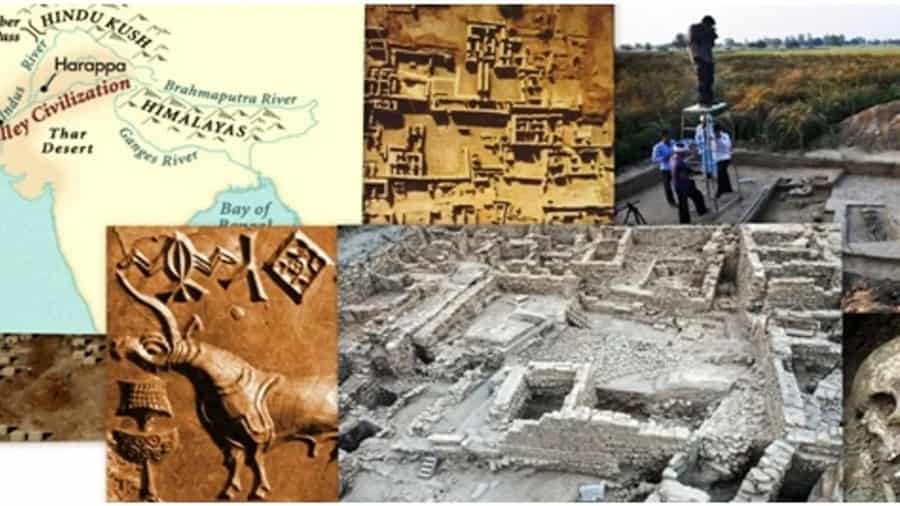
If we are talking about the origins of Hinduism, then the best place to start would be from the ancient Indus Valley Civilization. Students of history do not need any introduction to what the ancient Indus Valley civilization actually is.
One of the oldest human settlements, you can easily learn a lot about Hinduism by exploring the ruins of Harappa and Mohenjo-Daro. Here, you can easily find about intriguing artifacts, such as the ‘Pashupati Seal’ and terracotta figurines, that were prominent during that period. They are a significant indicator of the proto-Hindu deities and rituals that existed during those times.
So, while we cannot pinpoint the exact origin of Hinduism, we can make a pretty good enough guess about its beginning.
Vedic Period
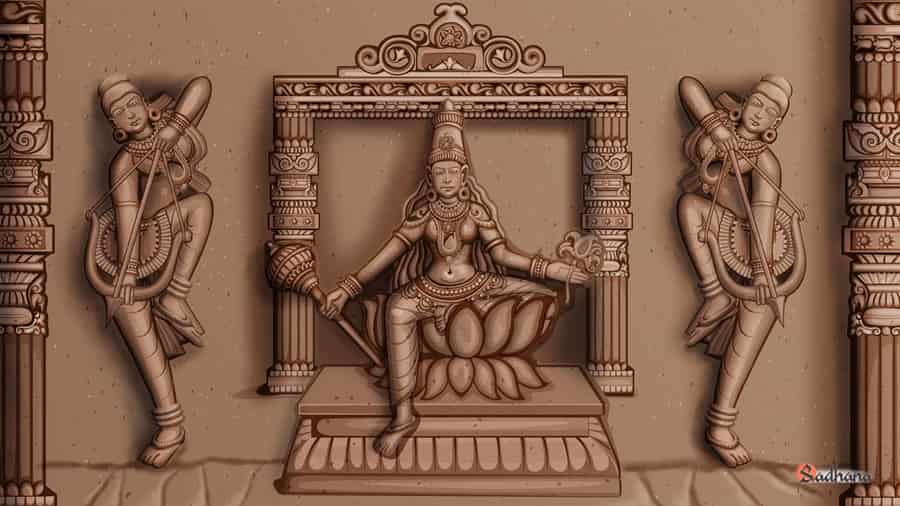
After exploring the ruins of the Indus Valley Civilization, we must turn our heads toward the Vedic period, which, according to most historians, happened between 1500 BCE and 500 BCE. This period begins with the arrival of Aryans from Central Asia. The Rigveda—the oldest and most important of all Vedas—as well as other Vedas—were written during this period, hence its name. Also, this is the period when the caste system emerged, dividing society into four main classes.
Epic and Puranic Period
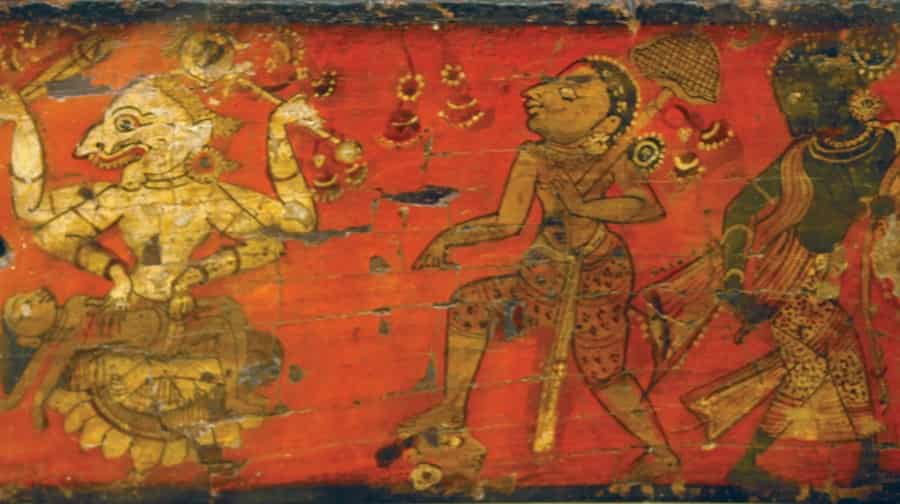
Many of the readers might already be familiar with two of the most important and popular epics that are relevant to Hinduism. We are, of course, talking about the Ramayana and Mahabharata. But do you know these were composed during this period? Yes, these two epics, which explored the complex themes of dharma & struggle between good and evil, were written between 500 BCE and 500 CE. Do note that in addition to these, many other stories that are popular in Hinduism were written during this golden age.
The Rise of Devotional Hinduism
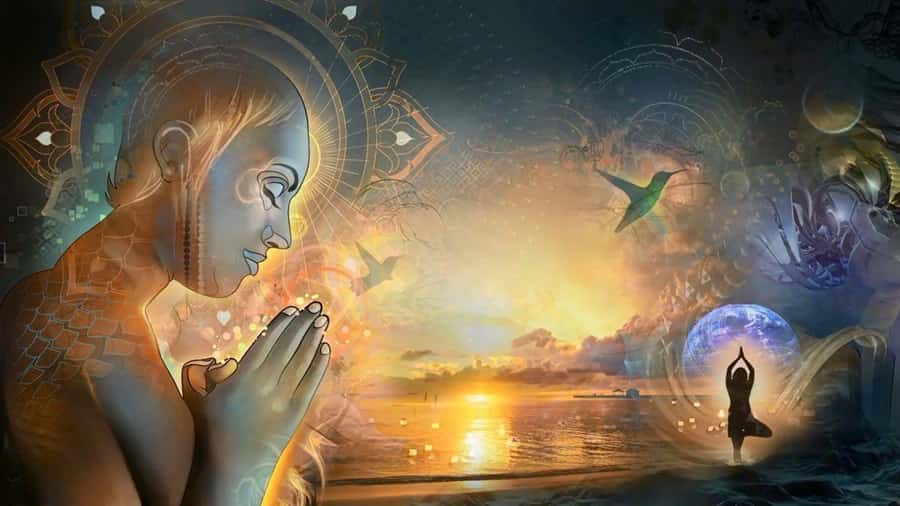
Till now, we have explored the origins of Hinduism, where reliable information is hard to come by. Now, we are moving on to the history of this faith, starting with the rise of devotional Hinduism between the 4th & 11th century CE.
The medieval period witnessed the rise of Bhakti movements on the Indian subcontinent. During this period, devotion to a personal God became central to Hindu worship. The shift started in Southern India, but it soon spread across the subcontinent. Gone were the restraint devotion of older texts; folks started to express their devotion to their chosen deity, and quite vocally; in fact, many texts, poetry, and songs have survived the years. This led to a more accessible form of worship, which also connected with common people, making the faith even more prevalent.
Hinduism in the age of Islam
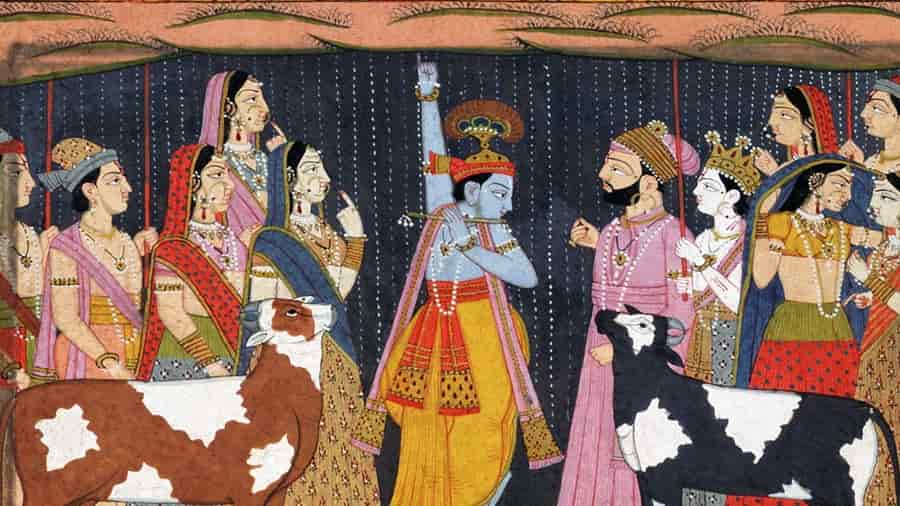
Finally, we must turn our heads towards the modern version of Hinduism we see nowadays. And to understand it, we have to focus on the arrival of Islam in India, starting in the 11th century.
Muslim rule in India, especially in the Northern region, presented both challenges and opportunities. The subcontinent, again mainly the northern plains, saw large periods of conflicts and the destruction of temples. However, as Hinduism encountered the challenge of facing a new religion, the Bhakti movements advocating passionate devotion to a personal God gained momentum. In some ways, the presence of a distinct religion like Islam solidified Hindu identity and core practices.
Core Beliefs of Hinduism
Now that we have talked about the origins of Hinduism and even delved into its history, how it changed, but now it is time to focus on explaining what are the core beliefs of this faith. And while it is impossible for us to mention all the core beliefs of Hinduism here – many spend their whole life studying this – we have done our best to list some of the most prominent beliefs that form the foundation of modern Hinduism.
Brahman & Atman
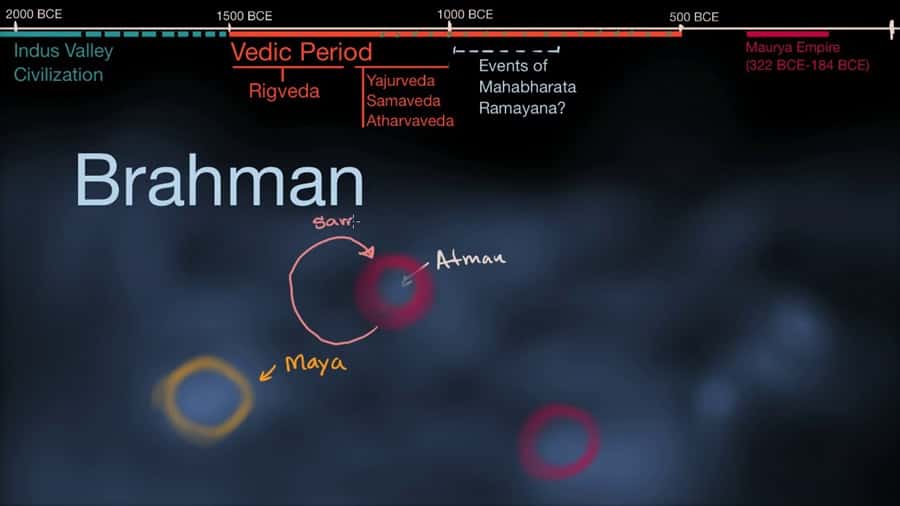
At the very heart of Hinduism lies the concept of Brahman. Now, this concept states that there is an ultimate reality, a cosmic consciousness, if you will, that permeates all existence. This existence is the source from which everything emerged and into which everything will dissolve at the end of time.
One way you can think of this existence as a vast, boundless ocean. Within this ocean exists your individual soul (this is the Atman). Like a single drop of water is inseparable from this ocean, the same way your soul is a part of Brahman.
Karma, Samsara & Moksha
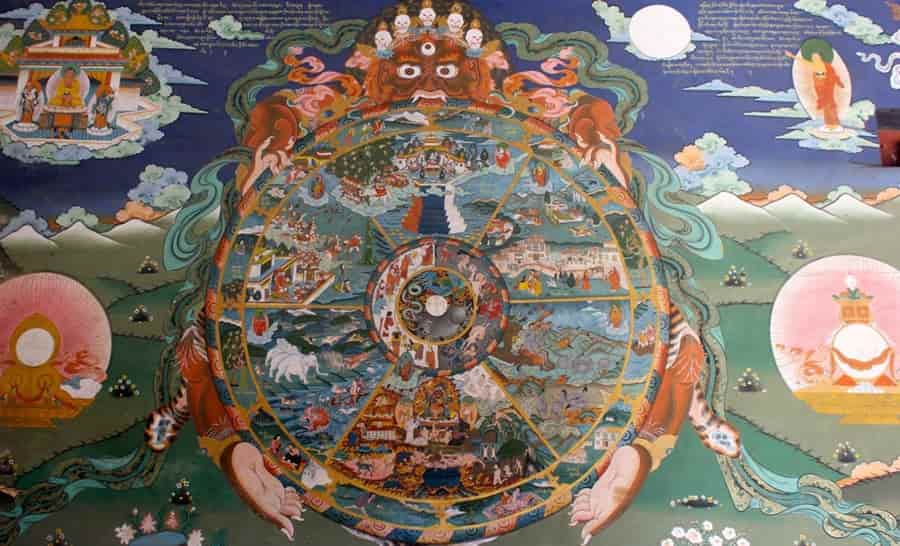
Now, another concept that is quite crucial in Hinduism is related to the cycle of Life and Liberation. You might have heard of them; they are called Karma, Samsara, and Moksha. Now, let’s understand what they mean – one by one.
Karma: It is the fundamental law in Hinduism. Think of it like gravity in the physical world – nothing in the world can function without it. That is the importance of this concept. Karma means “action”, including both the actions we make and the consequences we have to face due to it. Every thought, word, and deed creates an imprint that determines our future.
Samsara: Next is Samsara, which refers to the continuous cycle of birth, death, and rebirth—another crucial principle of Hinduism.
Moksha: Finally, we have the concept of Moksha. This is the ultimate goal of Hinduism: attaining peace and breaking from the endless cycle of birth, death, and rebirth. When one’s soul attains Moksha, one achieves peace and becomes one with Brahman.
The Four Purusharthas in Hinduism
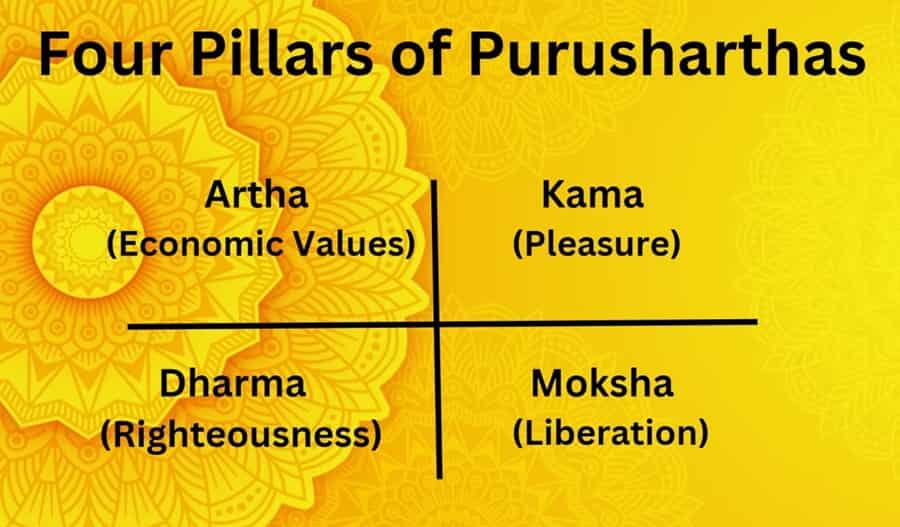
Finally, we must also talk about the four Purusharthas. They are a core tenant of Hinduism and provide devotees with a clear roadmap for living a wholesome and purposeful life. Here is what they say –
Dharma: If you are even a tiny bit familiar with Hinduism or have even read this blog post up until now, you must be familiar with how crucial Dharma is to this faith. It directly translates to righteous duty and moral being of the human being. Doing things right, upholding social order, etc., all come under the concept of Dharma.
Artha: This refers to the material prosperity & security that is achieved by the being during their time on the plane. However, do note that it only talks about doing so through ethical means.
Kama: This deals with desires, pleasures, and fulfillment (both sensual and aesthetic) that we as human beings need. The faith encourages healthy enjoyment of these without letting them become the sole focus in life.
Moksha: This is something that we have discussed in the earlier point as well. Moksha is the ultimate goal for those who follow this faith. By achieving Moksha, they would liberate themselves from Samsara, the constant cycle of rebirth and death, and achieve union with the divine.
Note that these four Purusharthas are all interconnected with each other, and not isolated stages. To live a meaningful life, a Hindu has to pursue all of them simultaneously. And these are the core principles of Hinduism as a whole. Next, we will look at some of the major deities of this faith.
Gods & Goddesses of Hinduism
Hinduism is quite different from many other major religions in the world today. Sure, the practices are quite different, but another area where this faith differs from others is because of its Polytheistic nature. Hinduism does not say there is only God, and everyone should pray to them. In this faith, there are many gods and goddesses – some more significant than others – but devotees are allowed to pray to whomever they want without any issues.
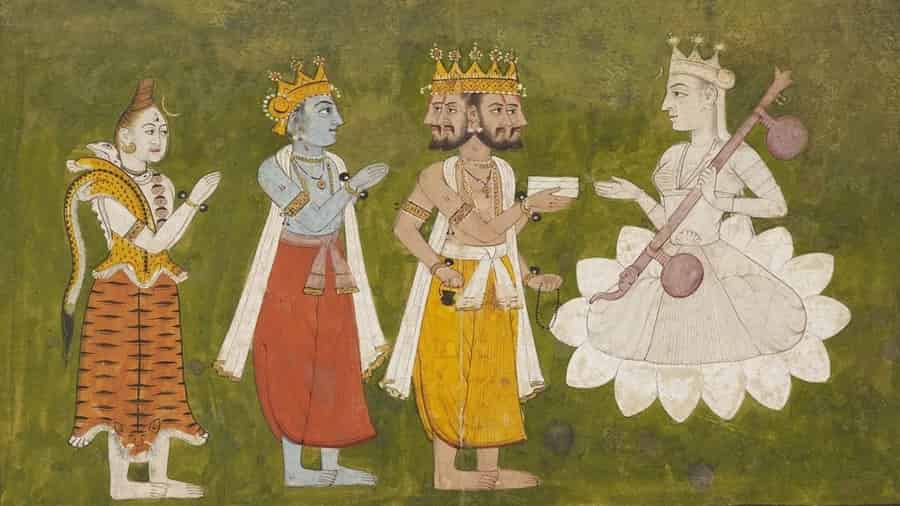
Here, let’s have a look at some of the major Gods and Goddesses in Hinduism:
The Trimurti
When talking about the many gods and goddesses of Hinduism, it is pretty easy for one to get lost. So, we should start from the very top and begin with the Trimurti – the group of three Supreme Gods in Hinduism: Brahma, Vishnu & Mahesh. These three deities hold a particularly central place in Hinduism:
Brahma, the Creator: He is the creator of life, symbolizing the creative force that sets the universe in motion. Brahma is often associated with wisdom and knowledge.
Vishnu, the Preserver: Lord Vishnu is another supreme being in the Hindu faith. He is responsible for upholding order and dharma and safeguarding the world from falling into chaos. To achieve that, Lord Vishnu often takes the form of an avatar, like Rama in the Ramayana and Krishna in Mahabharata. He descends in these forms during times of great imbalance to restore order and guide humanity.
Shiva, the Destroyer: The last of three is Shiva, who is the supreme God of destruction in Hinduism. His role is quite crucial, as without destruction, there can be no creation. So, his role is a necessary part of facilitating renewal and progress – something that is ever so crucial in this faith.
- Also Read: 12 Jyotirlingas of Lord Shiva
Other significant Gods and Goddesses in Hinduism
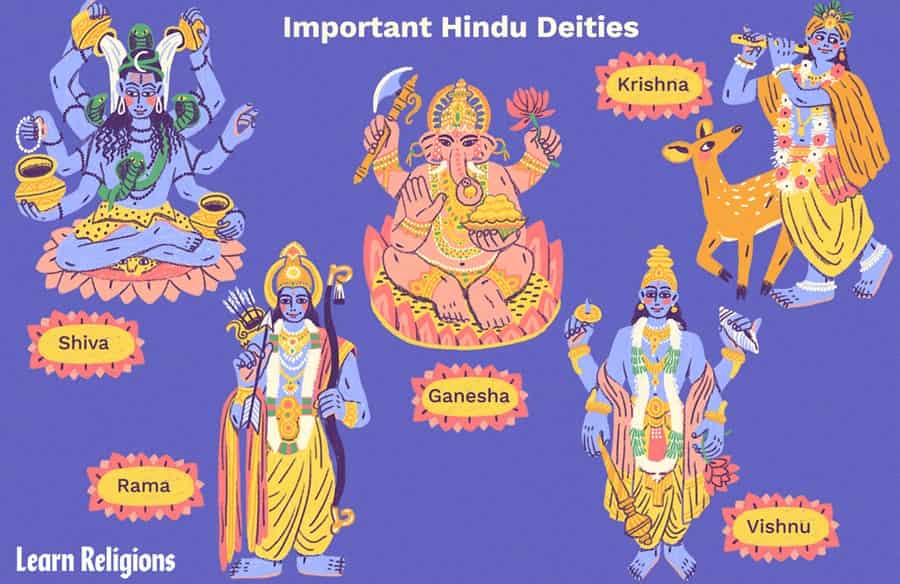
Some other beloved deities of Hinduism that you should know about:
- Ganesha – The beloved, elephant-headed god in Hinduism. He is the remover of obstacles, a symbol of auspiciousness beginning. Fun fact: He is the son of Lord Shiva and Devi Parvati.
- Laxmi – Goddess of property and fortune. It is believed that her blessing will bring wealth and prosperity to one’s home.
- Saraswati – Goddess of knowledge, arts and music.
- Hanuman – The monkey companion of Lord Rama. He is a central figure in the epic Ramayana.
- Durga – Destroyer of evil and protector of her devotees.
- Krishna – Eighth Avatar of Lord Vishnu
Some Facts about Hinduism
- Do you know that this faith places great emphasis on sacred sounds? Mantras, the recitation of scriptures, and the use of bells and music are all pretty common in rituals.
- Hindus often follow the concept of Ishta Devata. Sure, there are many gods and goddesses in Hinduism, but many followers often focus on their devotion to a particular god or goddess. This is Ishta Devata.
- When studying Hinduism, you will become aware of the vast and intricate cosmology of this faith. It involves multiple realms of existence, complex cycles of time, and the cosmic ages (Yugas).
- Hindu epics, philosophy, and symbolism have profoundly shaped Indian art, dance, music, and architecture over millennia.
- Yoga and Ayurveda have originated from Hinduism
Final Words
There you have it – a brief overview of Hinduism. Do note that while the blog is quite comprehensive, we have only scratched the surface of the rich and fascinating world of Hinduism. This faith is also not bound by a rigid set of rules or single texts. It is constantly evolving and adapting – just like it has done for thousands of years.

 Call
Call WhatsApp
WhatsApp Enquiry
Enquiry